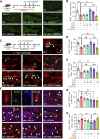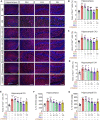Akebia saponin D protects hippocampal neurogenesis from microglia-mediated inflammation and ameliorates depressive-like behaviors and cognitive impairment in mice through the PI3K-Akt pathway
- PMID: 36110522
- PMCID: PMC9468712
- DOI: 10.3389/fphar.2022.927419
Akebia saponin D protects hippocampal neurogenesis from microglia-mediated inflammation and ameliorates depressive-like behaviors and cognitive impairment in mice through the PI3K-Akt pathway
Abstract
Given the ability of akebia saponin D (ASD) to protect various types of stem cells, in the present study, we hypothesized that ASD could promote the proliferation, differentiation, and survival of neural stem/precursor cells (NSPCs), even in a microglia-mediated inflammatory environment, thereby mitigating inflammation-related neuropsychopathology. We established a mouse model of chronic neuroinflammation by exposing animals to low-dose lipopolysaccharide (LPS, 0.25 mg/kg/d) for 14 days. The results showed that chronic exposure to LPS strikingly reduced hippocampal levels of PI3K and pAkt and neurogenesis in mice. In the presen of a microglia-mediated inflammatory niche, the PI3K-Akt signaling in cultured NSPCs was inhibited, promoting their apoptosis and differentiation into astrocytes, while decreasing neurogenesis. Conversely, ASD strongly increased the levels of PI3K and pAkt and stimulated NSPC proliferation, survival and neuronal differentiation in the microglia-mediated inflammatory niche in vitro and in vivo. ASD also restored the synaptic function of hippocampal neurons and ameliorated depressive- and anxiety-like behaviors and cognitive impairment in mice chronically exposed to LPS. The results from network pharmacology analysis showed that the PI3K-AKT pathway is one of the targets of ASD to against major depressive disorder (MDD), anxiety and Alzheimer's disease (AD). And the results from molecular docking based on computer modeling showed that ASD is bound to the interaction interface of the PI3K and AKT. The PI3K-Akt inhibitor LY294002 blocked the therapeutic effects of ASD in vitro and in vivo. These results suggested that ASD protects NSPCs from the microglia-mediated inflammatory niche, promoting their proliferation, survival and neuronal differentiation, as well as ameliorating depressive- and anxiety-like behaviors and cognitive impairment by activating the PI3K-AKT pathway. Our work suggests the potential of ASD for treating Alzheimer's disease, depression and other cognitive disorders involving impaired neurogenesis by microglia-mediated inflammation.
Keywords: PI3K-Akt signaling pathway; akebia saponin D; cognitive impairment; depression; microglia; neural stem/precursor cell; neurogenesis; neuroinflammation.
Copyright © 2022 Liu, Zhang, Xiao, Su, Li, Yang, Zhao, Jiang, You and Zhou.
Conflict of interest statement
The authors declare that the research was conducted in the absence of any commercial or financial relationships that could be construed as a potential conflict of interest.
Figures












Similar articles
-
Akebia saponin D acts via the PPAR-gamma pathway to reprogramme a pro-neurogenic microglia that can restore hippocampal neurogenesis in mice exposed to chronic mild stress.CNS Neurosci Ther. 2023 Sep;29(9):2555-2571. doi: 10.1111/cns.14196. Epub 2023 Mar 29. CNS Neurosci Ther. 2023. PMID: 36987659 Free PMC article.
-
The secretome of microglia induced by IL-4 of IFN-γ differently regulate proliferation, differentiation and survival of adult neural stem/progenitor cell by targeting the PI3K-Akt pathway.Cytotechnology. 2022 Jun;74(3):407-420. doi: 10.1007/s10616-022-00534-2. Epub 2022 Apr 24. Cytotechnology. 2022. PMID: 35733698 Free PMC article.
-
Priming of microglia with IFN-γ impairs adult hippocampal neurogenesis and leads to depression-like behaviors and cognitive defects.Glia. 2020 Dec;68(12):2674-2692. doi: 10.1002/glia.23878. Epub 2020 Jul 11. Glia. 2020. PMID: 32652855
-
Altered Insulin Signaling in Alzheimer's Disease Brain - Special Emphasis on PI3K-Akt Pathway.Front Neurosci. 2019 Jun 18;13:629. doi: 10.3389/fnins.2019.00629. eCollection 2019. Front Neurosci. 2019. PMID: 31275108 Free PMC article. Review.
-
The intricate interplay between microglia and adult neurogenesis in Alzheimer's disease.Front Cell Neurosci. 2024 Sep 18;18:1456253. doi: 10.3389/fncel.2024.1456253. eCollection 2024. Front Cell Neurosci. 2024. PMID: 39360265 Free PMC article. Review.
Cited by
-
Neuroinflammation, memory, and depression: new approaches to hippocampal neurogenesis.J Neuroinflammation. 2023 Nov 27;20(1):283. doi: 10.1186/s12974-023-02964-x. J Neuroinflammation. 2023. PMID: 38012702 Free PMC article. Review.
-
Microglial priming by IFN-γ involves STAT1-mediated activation of the NLRP3 inflammasome.CNS Neurosci Ther. 2024 Oct;30(10):e70061. doi: 10.1111/cns.70061. CNS Neurosci Ther. 2024. PMID: 39392762 Free PMC article.
-
Administration of Akebia Saponin D Improved Blood Lipid Levels and Pregnancy Outcomes in Mice with Gestational Diabetes Mellitus.Balkan Med J. 2023 Oct 20;40(6):422-429. doi: 10.4274/balkanmedj.galenos.2023.2023-6-82. Epub 2023 Oct 10. Balkan Med J. 2023. PMID: 37815409 Free PMC article.
-
Therapeutic Mechanisms of Medicine Food Homology Plants in Alzheimer's Disease: Insights from Network Pharmacology, Machine Learning, and Molecular Docking.Int J Mol Sci. 2025 Feb 27;26(5):2121. doi: 10.3390/ijms26052121. Int J Mol Sci. 2025. PMID: 40076742 Free PMC article.
-
Adult hippocampal neurogenesis: pharmacological mechanisms of antidepressant active ingredients in traditional Chinese medicine.Front Pharmacol. 2023 Dec 12;14:1307746. doi: 10.3389/fphar.2023.1307746. eCollection 2023. Front Pharmacol. 2023. PMID: 38152691 Free PMC article. Review.
References
-
- Alavi S., Darharaj M., Bilehsavar S. H., Amini M., Zafarghandi M. B. S., Berenji V., et al. (2021). Successful use of minocycline for the treatment of methamphetamine-induced psychosis and cognitive impairments: An open-label case series. Clin. Neuropharmacol. 44, 126–131. 10.1097/WNF.0000000000000460 - DOI - PubMed
-
- Bassani T. B., Bonato J. M., Machado M. M. F., Cóppola-Segovia V., Moura E. L. R., Zanata S. M., et al. (2018). Decrease in adult neurogenesis and neuroinflammation are involved in spatial memory impairment in the streptozotocin-induced model of sporadic Alzheimer's disease in rats. Mol. Neurobiol. 55, 4280–4296. 10.1007/s12035-017-0645-9 - DOI - PubMed
LinkOut - more resources
Full Text Sources

